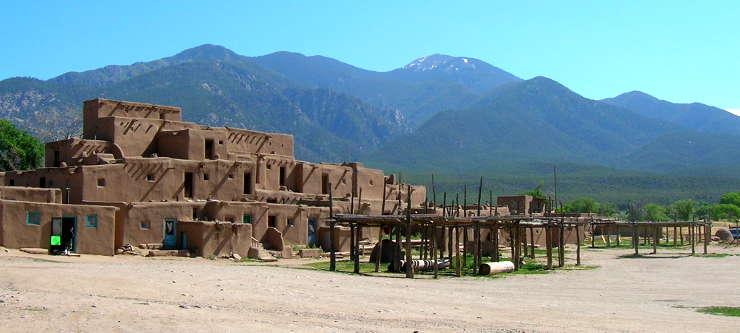The Spanish
Missionaries Pick Up the Pieces
A solid study of how Spanish
missionaries reacted after the Pueblo
Revolt and how it influenced
their actions going forward.
After the Spanish reconquest,
Missionaries were fearful of another rebellion due to the Pueblo
revolt having been so devastating. As a result there was a lot
less enthusiasm for trying to destroy existing Pueblo religious
practices. There were several weak attempts to restore lost
missions, but these were not very well supported by the royals.
The feelings of Natives towards Spanish missionaries were very bitter,
this and the
now timid attitude of Spanish missionaries after the revolt
arguably gave the English a perfect opportunity to take
advantage of the situation. This resulted in them numerous attempts to offer
‘protection’ from the Spanish.
Primary Sources
- Hackett, Charles Wilson. Revolt of the Pueblo Indians of New
Mexico and OtermiÌn's Attempted Reconquest: 1680 - 1682. Vol. 8. Albuquerque: U of New Mexico Pr, 1970.
Print.
To make sense of the changes in attitude over time, it is also
important to understand the previously held viewpoints and
thoughts of those involved. This source contains numerous
versions of both Spanish and Indian accounts of the pueblo revolt as
well as documents by Spanish leader Don Antonio de Otermín as
he attempted to make sense of the events occurring at the
time. This source was found looking through the public
library’s directory searching using the key term “pueblo revolt”.
- Cushing, Frank Hamilton, and
Jesse Green. ZunÌ: Selected
Writings of Frank Hamilton Cushing.
Lincoln: U of Nebraska, 1981. Print.
Frank Hamilton
Cushing stayed at a Zuni pueblo from 1879 to 1884, and is
accredited as the first anthropologist to live with his
subjects. There is an important chapter within this
first-person account entitled “Zuni and the Missionaries:
Keeping the Old Ways”, in which the author recounts a
conversation about the Zuni’s attitude towards the Spanish missionaries and their teachings and his reaction to
it. The attitude of the Natives about the Spanish is key in
finding out how the Missionaries reacted after the pueblo revolt as
evidence for backing up or contrasting against Spanish
accounts, as the truth in each other’s perception of each
other is probably somewhere in the middle. This was a book
leant to me from Maggie Duval (er… my mother), from her collection of books on
New Mexico history.
- Weber, David J. Foreigners in Their Native Land: Historical
Roots of the Mexican Americans.
Albuquerque: U of New Mexico, 2003. Print.
This book recounts Spanish history, but contains dozens of
first person accounts before and after the time and location I
am concerned with. It offers an important
perspective on Spanish views about the events before and after
the revolt as well as their view of natives. This source was
found in the public library directory in a search about
Spanish missionaries.
Secondary Sources
- Weber, David J. The Spanish Frontier in North America. New Haven: Yale UP, 1992. Print.
This book is a very detailed account of the Spanish impact
on the lives of Natives and includes amazing details
about the Spanish missions. It is very thorough on the events during and after the
pueblo revolt. It is very heavily cited with a section of notes that takes up
most of the second half of the book.
- Roberts, David. The Pueblo Revolt: The Secret Rebellion That
Drove the Spaniards Out of the
Southwest. New York: Simon &
Schuster Paperbacks, 2005. Print.
This book is a historical record with descriptive language that points out biases in the Spanish documents
that still survives to this day. The
author presents a lot of information and uses many maps to his
advantage.
- Silverberg, Robert. The Pueblo Revolt.
Lincoln: U of Nebraska, 1994. Print.
This is another study and account of the Pueblo revolt; its use
here is mainly to back up the accounts of other sources with
the unique writing and research of another author to check for
biases of other writings.
- "Texas Almanac - The Source
For All Things Texan Since 1857." Fate of Spanish Mission Changed Face of West Texas | Texas
Almanac. Texas State Historical
Association, n.d. Web. 24 Apr. 2017.
This citation is more about
Texas history and how the missions and revolt influenced it’s
development, but it has some important information about Spanish
procedures after the revolt that have some use as a ‘back up
source’.
- *"Palace of the
Governors--American Latino Heritage: A Discover Our Shared
Heritage Travel Itinerary." National
Parks Service. U.S. Department
of the Interior, n.d. Web. 24 Apr. 2017. https://www.nps.gov/nr/travel/american_latino_heritage/Palace_of_the_Governors.html
This is a sort
of “half” resource, It’s mostly just a little tidbit about the
Palace of the Governors, the oldest surviving European structure
in North America. It’s a ‘half’ resource because it’s interesting, but
there isn’t much about the revolt or the missionaries to support
this paper, however it’s worth a mention

Figure 1.
A Spanish missionary striking a pose
to show off his fashionable new robes + Bible (probably)

Figure 2. Present day Taos, NM
Pueblo

Figure 3. San Geronimo de los
Taos Mission, New Mexico
Prepared by Hunter Tripp
